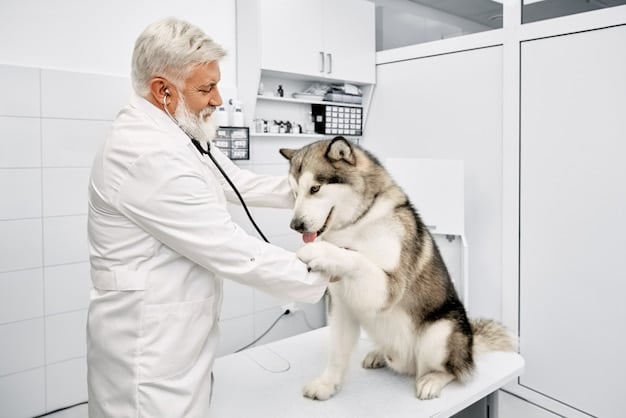Destructive Behavior in Senior Dogs: Causes & Solutions

Destructive behavior in senior dogs can stem from anxiety, boredom, pain, or cognitive decline; identifying the root cause is crucial for implementing effective management strategies like environmental enrichment, training adjustments, and veterinary care.
Discovering your senior dog engaging in destructive behavior in senior dogs: identify the cause and find solutions can be both frustrating and concerning, sparking worries about their well-being and reasons for the sudden behavioral change.
Understanding Destructive Behavior in Senior Dogs
Destructive behavior in senior dogs can manifest in various ways, from chewing furniture to digging at carpets. It’s essential to understand that this behavior is often a symptom of an underlying issue, rather than simple disobedience.
As dogs age, they experience physical and cognitive changes that can impact their behavior. Recognizing these changes and their potential influence on destructive tendencies is the first step towards finding effective solutions.
Common Types of Destructive Behavior
Senior dogs may exhibit different forms of destructive behavior, each potentially indicative of a specific underlying cause.
- Chewing: Excessive chewing, especially on inappropriate items, is a common sign.
- Digging: Digging at carpets or furniture can indicate anxiety or frustration.
- Scratching: Scratching at doors or windows may suggest separation anxiety or a desire to escape.
- House Soiling: Accidents in the house, despite previous training, can be related to medical issues or cognitive decline.
These behaviors, while frustrating, are often a dog’s way of communicating discomfort or unmet needs. Identifying the specific type of destructive behavior can help narrow down the potential causes and guide appropriate interventions.
In conclusion, understanding the types of destructive behavior is crucial for proper diagnosis and solutions.
Medical Causes of Destructive Behavior
Medical conditions can significantly contribute to destructive behavior in senior dogs. Pain, discomfort, and cognitive decline can all manifest as behavioral changes, including increased destructiveness.
It’s important to consult with a veterinarian to rule out any underlying medical issues before assuming the behavior is purely psychological.

Pain and Discomfort
Chronic pain, such as arthritis or hip dysplasia, can cause irritability and anxiety, leading to destructive behavior. A dog in pain may chew or scratch at objects in an attempt to alleviate discomfort or distract themselves from the pain.
Dental issues, such as tooth decay or gum disease, can also cause pain and contribute to chewing behavior. Regular veterinary check-ups can help identify and manage these painful conditions.
Pain medications and therapies can significantly improve a dog’s comfort level and reduce the likelihood of destructive behavior. In addition, creating a comfortable environment with soft bedding and easy access to resources is essential.
In conclusion, addressing medical issues promptly can alleviate pain and behavior.
Behavioral and Environmental Factors
Beyond medical issues, behavioral and environmental factors can also play a significant role in destructive behavior in senior dogs. Changes in routine, lack of mental stimulation, and anxiety can all contribute to these behaviors.
Understanding these factors and making appropriate adjustments to a dog’s environment and routine can help reduce or eliminate destructive tendencies.
- Changes in Routine: Senior dogs thrive on routine, and any disruption can cause anxiety and stress.
- Lack of Mental Stimulation: Boredom and lack of mental stimulation can lead to destructive behavior as dogs seek ways to entertain themselves.
- Separation Anxiety: Senior dogs may develop or worsen separation anxiety, leading to destructive behavior when left alone.
- Fear and Phobias: Loud noises or other triggers can cause fear and anxiety, resulting in destructive behavior as dogs attempt to escape or hide.
Addressing environmental and behavioral factors in conjunction with veterinary help is a more complete approach to stop these behaviors. Mental stimulation with toys and addressing anxiety head on can make a significant impact.
In summary, focusing on both medical and behavioral factors can stop destructive behaviors.
Cognitive Decline and Destructive Behavior
Cognitive decline, also known as canine cognitive dysfunction (CCD), is a common issue in senior dogs that can significantly impact their behavior. CCD is similar to Alzheimer’s disease in humans and can cause confusion, disorientation, and memory loss, leading to destructive behaviors.
Recognizing the signs of CCD and implementing appropriate management strategies is essential for improving a dog’s quality of life and reducing destructive tendencies.
Signs of Cognitive Decline
Identifying cognitive decline in senior dogs can be challenging, as symptoms may develop gradually and mimic other age-related changes.
Common signs of CCD include:
- Disorientation: Getting lost in familiar places or pacing aimlessly.
- Changes in Sleep Patterns: Sleeping more during the day and less at night.
- Loss of House Training: Accidents in the house despite previous training.
- Social Interaction Changes: Decreased interest in interacting with family members or other pets.
If you notice any of these signs, it’s important to consult with a veterinarian to determine if CCD is a contributing factor to your dog’s destructive behavior. Early diagnosis and intervention can help slow the progression of the disease and improve your dog’s overall well-being.

Therefore, keeping a close watch on your dog’s behavior and mental state can help prevent destructive habits.
Strategies to Manage Destructive Behavior
Managing destructive behavior in senior dogs requires a multi-faceted approach that addresses both the underlying causes and the specific behaviors. This may involve medical interventions, behavioral modifications, and environmental adjustments.
Consistency and patience are key to success, as it may take time to identify the most effective strategies for your individual dog.
Environmental Enrichment
Providing a stimulating and enriching environment is essential for reducing boredom and anxiety, which can contribute to destructive behavior. Some ways to enrich your dog’s environment include:
- Puzzle Toys: These toys challenge dogs mentally and physically, providing a healthy outlet for their energy.
- Chew Toys: Offering a variety of appropriate chew toys can help redirect chewing behavior away from furniture and other household items.
- Regular Exercise: Even gentle exercise, such as short walks or indoor play sessions, can help reduce pent-up energy and anxiety.
Behavioral Modification
Behavioral modification techniques can help redirect destructive behavior and teach dogs more appropriate ways to cope with stress or boredom.
Positive reinforcement training, such as rewarding desired behaviors with treats or praise, can be effective. Avoid punishment, as it can increase anxiety and worsen the problem.
Consulting with a certified professional dog trainer or veterinary behaviorist can provide personalized guidance and support.
Therefore, it’s important to provide the proper amount of fun and enrichment to keep a dog happy.
When to Seek Professional Help
While many cases of destructive behavior in senior dogs can be managed with home remedies and lifestyle adjustments, there are times when professional help is necessary.
If your dog’s destructive behavior is severe, sudden, or accompanied by other concerning symptoms, it’s important to consult with a veterinarian or veterinary behaviorist.
Signs That You Need Professional Help
- Severe Destructive Behavior: Damage to property or potential harm to themselves.
- Sudden Onset: A sudden change in behavior that cannot be explained by environmental factors.
- Aggression: Destructive behavior accompanied by aggression towards people or other animals.
- Lack of Response to Home Remedies: Destructive behavior that persists despite consistent efforts to manage it at home.
A veterinarian can rule out underlying medical issues and refer you to a veterinary behaviorist, who can develop a customized treatment plan that addresses your dog’s specific needs. Prescription medications, such as anti-anxiety drugs, may be necessary in some cases.
To conclude, don’t be afraid to ask for outside help if you need it.
| Key Point | Brief Description |
|---|---|
| 🩺 Medical Causes | Pain, discomfort, or cognitive decline can lead to destructive tendencies. |
| 🏡 Environmental Factors | Changes in routine, lack of stimulation, and anxiety can trigger unwanted behavior. |
| 🧠 Cognitive Decline | CCD causes confusion, disorientation, and memory loss, leading to destructive behavior. |
| 🧩 Management Strategies | Environmental enrichment, behavioral modification, and professional help are vital. |
Frequently Asked Questions
▼
Sudden destructive behavior can indicate underlying medical issues, such as pain or cognitive decline, or an unmet need for stimulation. Consult a vet to determine the cause.
▼
Provide appropriate chew toys, increase mental stimulation, and ensure there are no underlying medical issues causing the behavior. Redirection and positive reinforcement are key.
▼
Yes, senior dogs can develop or worsen separation anxiety due to cognitive decline or increased dependence. Gradual desensitization and creating a safe space can help.
▼
Yes, cognitive decline can cause confusion and disorientation, leading to destructive behaviors. Management includes environmental enrichment, medication, and a consistent routine.
▼
Consult a vet if the behavior is sudden, severe, or accompanied by other symptoms like aggression or loss of appetite. Underlying medical conditions need to be ruled out.
Conclusion
Addressing destructive behavior in senior dogs requires an understanding approach and systematic problem-solving. By identifying the root causes—whether medical, behavioral, or environmental—and implementing tailored strategies, owners can significantly improve their senior dog’s quality of life, stopping destruction and creating a peaceful home.





